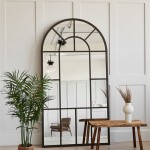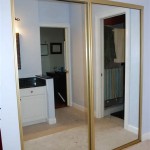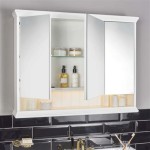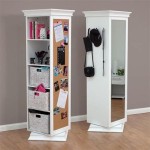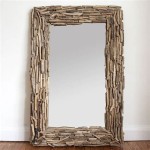Painting Mirror Frame Ideas: A Comprehensive Guide
Mirrors serve not only a functional purpose but also contribute significantly to a room's aesthetic appeal. The frame surrounding a mirror plays a pivotal role in its overall impact. While commercially available framed mirrors offer a multitude of styles, painting a mirror frame provides a personalized and cost-effective way to enhance a room’s decor. This article explores various painting ideas for mirror frames, covering surface preparation, paint types, design techniques, and considerations for different frame materials.
Surface Preparation: The Foundation for a Flawless Finish
Proper surface preparation is paramount for achieving a professional-looking paint job on a mirror frame. The specific steps involved will vary depending on the frame material and its existing finish. Neglecting this crucial stage can lead to paint adhesion problems, uneven coverage, and a less durable final product.
For wooden frames, the first step involves cleaning the surface to remove dust, dirt, and any existing grime. A mild detergent and water solution is generally sufficient. For frames with a glossy finish, sanding is necessary to create a slightly roughened surface that provides better adhesion for the new paint. Use a fine-grit sandpaper (e.g., 220-grit) and sand lightly in the direction of the wood grain. Be careful not to apply excessive pressure, as this can damage the wood. After sanding, remove sanding dust with a tack cloth or damp cloth.
If the wooden frame has any imperfections, such as dents or scratches, fill them with wood filler and allow it to dry completely according to the manufacturer's instructions. Sand the filled areas smooth and feather the edges for a seamless transition. Priming the wooden frame is highly recommended, especially if the wood is bare or has been previously painted with a dark color. Primer creates a uniform surface, blocks stains, and enhances paint adhesion. Choose a primer that is compatible with the type of paint you intend to use. Apply the primer in thin, even coats, allowing each coat to dry completely before applying the next.
Metal frames should also be thoroughly cleaned to remove any rust, grease, or dirt. Use a wire brush or sandpaper to remove rust. For greasy surfaces, use a degreasing cleaner. Priming is essential for metal frames to prevent rust and ensure proper paint adhesion. Use a metal primer specifically designed for the type of metal the frame is made of. As with wooden frames, apply the primer in thin, even coats, allowing each coat to dry completely before applying the next.
Plastic frames require careful cleaning to remove any mold release agents or contaminants that may interfere with paint adhesion. Wash the frame with soap and water, then lightly sand it with fine-grit sandpaper. Plastic primers are available and highly recommended for plastic frames. These primers are formulated to bond to plastic surfaces and provide a stable base for paint.
For all frame materials, masking off the mirror glass is crucial to prevent accidental paint splatters. Use painter's tape to carefully cover the edges of the mirror, ensuring a clean and straight line. Press the tape firmly to the glass to prevent paint from seeping underneath. If necessary, you can also use newspaper or plastic sheeting to cover the entire mirror surface for added protection.
Paint Types and Application Techniques
Selecting the appropriate type of paint is crucial for achieving the desired finish, durability, and aesthetic appeal. Various paint types are available, each offering distinct characteristics and benefits.
Acrylic paint is a versatile and widely used option for painting mirror frames. It is water-based, dries quickly, and offers good coverage and durability. Acrylic paints are available in a wide range of colors and finishes, including matte, satin, semi-gloss, and gloss. They are also relatively easy to clean up with soap and water. However, acrylic paints may not be as resistant to scratches and scuffs as some other paint types.
Latex paint is another water-based option that is similar to acrylic paint in many respects. It is easy to apply, dries quickly, and offers good coverage. Latex paints are generally more durable and resistant to moisture than acrylic paints, making them a good choice for frames in bathrooms or other humid environments. However, latex paints can be more prone to mildew growth than some other paint types.
Oil-based paint offers exceptional durability, hardness, and resistance to scratches and abrasion. It provides a smooth, glossy finish that is often preferred for furniture and trim. Oil-based paints are also more resistant to chemicals and solvents than water-based paints. However, oil-based paints have a longer drying time, require mineral spirits for cleanup, and emit stronger fumes than water-based paints. Due to environmental regulations, the availability of oil-based paints may be limited in some areas.
Spray paint offers a convenient and efficient way to paint mirror frames, especially those with intricate details or hard-to-reach areas. Spray paint provides a smooth, even finish and dries quickly. It is available in a wide range of colors and finishes, including metallic and specialty effects. However, spray paint can be more prone to runs and drips than brush-applied paint, and it requires proper ventilation to avoid inhaling harmful fumes. When using spray paint, apply thin, even coats, overlapping each coat slightly to ensure complete coverage. Hold the spray can approximately 10-12 inches from the frame and move it in a consistent, back-and-forth motion.
Specialty paints, such as chalk paint, milk paint, and metallic paint, can be used to create unique and distinctive finishes on mirror frames. Chalk paint provides a matte, velvety finish that is ideal for creating a distressed or vintage look. Milk paint is a natural, eco-friendly option that creates a slightly textured, matte finish. Metallic paints add a touch of glamour and sophistication to mirror frames. When using specialty paints, follow the manufacturer's instructions carefully, as application techniques and drying times may vary.
When applying paint, use high-quality brushes or rollers designed for the type of paint you are using. For smooth surfaces, a foam roller can provide a flawless finish. For detailed areas, use a small, angled brush. Apply the paint in thin, even coats, allowing each coat to dry completely before applying the next. Avoid applying too much paint at once, as this can lead to runs and drips. Sand lightly between coats with fine-grit sandpaper to create a smooth, even surface for the next coat of paint.
Design Techniques and Creative Ideas
Beyond choosing the color, various design techniques can elevate the painted mirror frame from simple to stunning, adding character and reflecting personal style. These techniques range from simple color blocking to more elaborate stenciling and distressing.
Color blocking involves painting different sections of the frame in contrasting colors. This technique can be used to highlight architectural details or to create a modern, geometric look. Choose colors that complement each other and the overall color scheme of the room. Use painter's tape to create clean lines between the different color blocks.
Stenciling allows for the addition of intricate patterns and designs to the mirror frame. Stencils can be purchased at craft stores or created at home using cardboard or acetate sheets. Secure the stencil to the frame with painter's tape and apply the paint using a stencil brush or sponge. Remove the stencil carefully while the paint is still wet to avoid smudging. Experiment with different stencils and paint colors to create unique and personalized designs. Consider using metallic paints or glitter for added visual interest.
Distressing creates a weathered or antique look by intentionally damaging the paint finish. This technique involves sanding away some of the paint to reveal the underlying layers or the bare frame material. After painting the frame, use fine-grit sandpaper to lightly sand the edges, corners, and raised details. The amount of sanding will depend on the desired level of distress. You can also use other tools, such as a wire brush or a screwdriver, to create more pronounced distressing effects. After distressing the frame, seal it with a clear coat of varnish or wax to protect the finish and prevent further damage.
Adding texture to the painted mirror frame can create a unique and visually appealing surface. This can be achieved by using textured paints or by applying texture mediums, such as joint compound or modeling paste. Textured paints come in a variety of finishes, including sand, stucco, and crackle. Texture mediums can be applied with a brush, sponge, or palette knife. After applying the texture, allow it to dry completely before painting. Consider using a glaze or wash to highlight the texture and add depth.
Ombre effect involves gradually blending two or more colors together to create a seamless transition. This technique can be used to create a soft and subtle gradient on the mirror frame. Start by painting the frame with the lightest color at the top and gradually blend in the darker color towards the bottom. Use a soft brush or sponge to blend the colors together seamlessly. Practice the ombre effect on a piece of scrap wood or cardboard before applying it to the mirror frame.
Gilding adds a touch of luxury and elegance to the mirror frame. This technique involves applying thin sheets of metal leaf, such as gold leaf or silver leaf, to the frame surface. Apply a layer of gilding adhesive to the frame and allow it to become tacky. Carefully apply the metal leaf to the adhesive surface, overlapping the edges slightly. Use a soft brush to smooth out the metal leaf and remove any excess. Seal the gilded surface with a clear coat of varnish to protect the finish.
These are just a few of the many design techniques that can be used to create a unique and personalized painted mirror frame. Experiment with different colors, textures, and patterns to find a style that reflects your personal taste and complements the decor of your home.

Painting A Mirror Frame Easy Yet Stunning Ideas Girl In The Garage

12 Techniques To Painting Antique Mirrors Hallstrom Home

12 Techniques To Painting Antique Mirrors Hallstrom Home

15 Thrifty Mirror Makeovers Confessions Of A Serial Do It Yourselfer

30 Diy Mirror Frames Scratch And Stitch

How To Paint A Mirror Frame Gold Easily In Two Steps

Ornate Mirror Makeover

Painting A Mirror Frame Easy Yet Stunning Ideas Girl In The Garage

Mirrors Eclectic Mirror Frame Diy Wall

Painted Mirror Using Paint Glaze To Enhance Details Sand And Sisal

